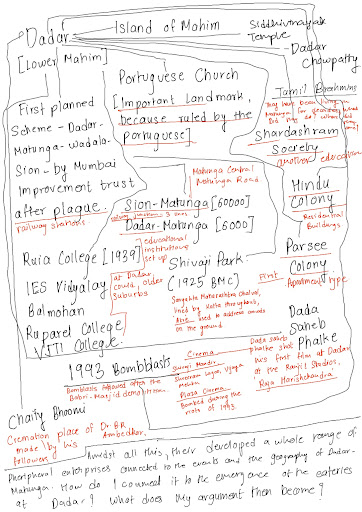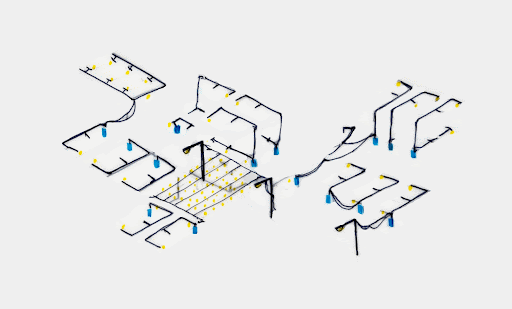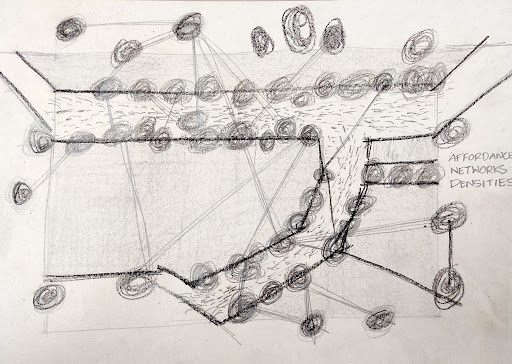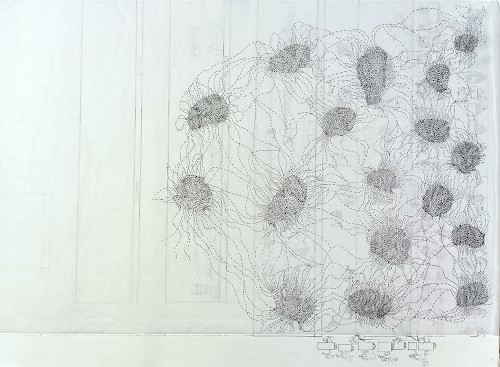Sem 9
Drawing Thinking II
Apurva Talpade
Three collections / excerpts from the structure of the fifth year thesis research to set up the course:
The research questions set up by students in the 9th semester for their theses currently encompass an arc that holds within it various scales that range from the near - rooted in their own experience of being migrants, of observing their mothers at home, their intrepid neighbours running home based business; to the far, and sometimes to the far-out even - concerns about what shapes belonging for people making homes in transit camp neighbourhoods, the role of infrastructure in shaping lives and sociality in housing types, urban enterprise and the networks that produce and uphold them, humanity’s relationship with the cosmos being mediated by built forms such as a garden of instruments for a king’s ardent pursuit of astronomy.
Girded by these questions and some fortitude, the field is then entered and a new set of questions and conceptualisations around the field are spawned.
How does the field open itself up? One may research stories of the neighbourhood, study maps of a city plaza across centuries, trace histories of local eateries, follow friends to observe their routines, make friends and ask them their routines (but also their desires and leisures), visit to keenly observe: classrooms, dense marketplaces, river edges, monuments.
One may re-familiarising yourself with the neighbourhood you grew up in, look closely at the nature of relationships that set up hierarchies within your own homes, reflect on the nature of home beyond those set up by the logics of the market economy as the BHK apartment.
The fieldwork that emerges has its own form.
The fieldwork is:
Long interviews, collaboratively produced, a hectic diary, impressions and photographs of an old woman’s room and world, a collection of maps of a plaza - from colonial, to post colonial to contemporary, layers of margin notes over hastily sketched plans as typological studies, stories gleaned and cross verified from several sources, notes on visitations by birds, crabs, humans along a stretch of coast.
In producing these, through the close engagement with the field, a sense of an analysis is emergent, though as yet nascent. The Drawing Thinking course enters at this particular point in the thesis research.The module is a new one, introduced for the first time this year. It is meant to intervene at this crucial stage in the thesis processes of fifth year students - where the fieldwork collected must be put to the task of eking out a hypothesis, must suggest and postulate a spatial argument. The argument, setting out to stake something, must do so by wielding the drawing, we maintain. The module mediates from this ground. It asks that the student put forward their claim regarding their spatial argument, and then, from that position, launch analyses and argue using the drawing. It is meant to extend a core conviction about drawing itself, conceptualised here in both its grammatical turns - as a noun and as a verb.
The drawing here, as a noun.
Where the drawing is much more than an inert document that enables you to set into motion the practices of building-making. The drawing is an entity, it has a life, it has an ambition, it builds its own relationships and encounters with the world and is a sufficient means therefore to build a spatial assertion.
Where the drawing is much more than an inert document that enables you to set into motion the practices of building-making. The drawing is an entity, it has a life, it has an ambition, it builds its own relationships and encounters with the world and is a sufficient means therefore to build a spatial assertion.
The drawing here, as a verb. Whereby in the act of the drawing, through the processes of drawing, one may inhabit a method that institutes a means of looking. The making of the method and its interrogation themselves are the forces which allow for a thinking that is agile and dynamic and curious, that shapeshifts since it is exploratory and makes itself up constantly and becomes a collaborator to dialogically produce a proposition.
At this stage, and for the purpose of this course, the drawing here is not meant to be burdened with the final form of the argument. Rather, it becomes a space for the question / proposition to take a fledgling form. However, the planets of the mind and of the page do not align neatly always. Rather than coinciding perfectly, they pass through each other's shadows and the drawing emerges from this play of umbra and penumbra. We steer their orbits by invoking as companions thinkers themselves in love with drawing - John Berger and Michael Taussig, Paul Klee and Joseph Beuys. And we read and decipher the many incarnations of the drawing - Drawing as Narrative, Drawing as Fields and Atmospheres, Drawing as Arguments, Speculations, to Illuminate the Unseen, Drawings as Subjective Fields and Fictions and so on.
It may have been a hurried course, it may have been wiser to not think of a thinking intervention as one that could lead to a drawing methodology that might be rendered visible, or rather successful, in the span of two weeks. However, there is a hope that it fostered a burgeoning sense of the importance of occupying methods and that it recast the drawing from an end, a closing, an outcome of thinking processes with intent and meaning thrust upon it, to a means of play and experimentation that allows for a subtle layering of the self in the making of it.










